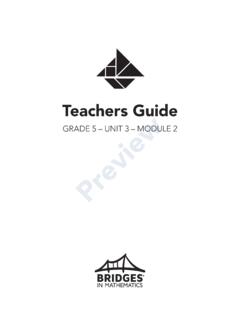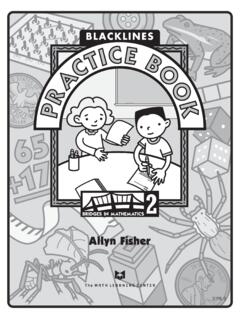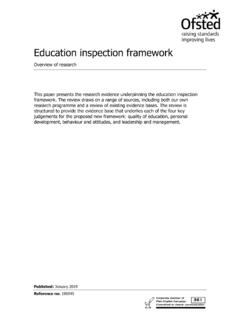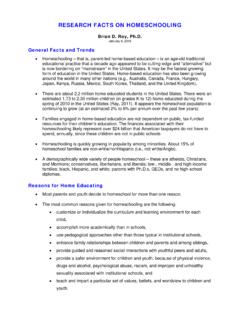Transcription of A Resource for Teachers, A Tool for Young Children © 2010 ...
1 Learning to Think Mathematically with the Number Line A Resource for Teachers, A Tool for Young Children by Jeffrey Frykholm, by The Math Learning Center 2010 The Math Learning Center. All rights reserved. The Math Learning Center, PO Box 12929, Salem, Oregon 97309. Tel 1 (800) 575-8130 published in 2010 by Cloudbreak Publishing, Inc., Boulder, Colorado (ISBN 978-1-4507-0140-2)The Math Learning Center grants permission to reproduce and share print copies or electronic copies of the materials in this publication for educational purposes. For usage questions, please contact The Math Learning Math Learning Center grants permission to writers to quote passages and illustrations, with attribution, for academic publications or research purposes.
2 Suggested attribution: Learning to Think Mathematically with the Number Line, Jeffrey Frykholm, Math Learning Center is a nonprofit organization serving the education community. Our mission is to inspire and enable individuals to discover and develop their mathematical confidence and ability. We offer innovative and standards- based professional development, curriculum , materials, and resources to support learning and teaching. ISBN: 978-1-60262-569-3 Learning to Think Mathematically with the Number LineA Resource for Teachers, A Tool for Young ChildrenAuthored by Jeffrey Frykholm, : This book prepares teachers with the theoretical basis, practical knowledge, and expertise to use the number line as a vigorous model for mathematical learning in grades K 5.
3 While the number line is a common artifact in elementary school classroom, it is seldom used to its potential. Learning to Think Mathematically with the Number Line helps teachers present lesson activities that foster students confidence, fluency, and facility with numbers. Working effectively with the number line model, students can develop powerful intuitive strategies for single- and multiple-digit addition and subtraction. Learning to Think Mathematically with the Number Line 2 About the Author Dr. Jeffrey Frykholm is an Associate Professor of Education at the University of Colorado at Boulder. As a former public school mathematics teacher, Dr. Frykholm has spent the last 20 years of his career teaching Young Children , working with beginning teachers in preservice teacher preparation courses, providing professional development support for practicing teachers, and working to improve mathematics education policy and practices across the globe (in the , Africa, South America, Central America, and the Caribbean).
4 Dr. Frykholm has authored over 30 articles in various math and science education journals for both practicing teachers, and educational researchers. He has been a part of research teams that have won in excess of six million dollars in grant funding to support research in mathematics education. He also has extensive experience in curriculum development, serving on the NCTM Navigations series writing team, and having authored two highly regarded curriculum programs: An integrated math and science, K-4 program entitled Earth Systems Connections (funded by NASA in 2005), and an innovative middle grades program entitled, Inside Math (Cambium Learning, 2009). This book, Learning to Think Mathematically with the Number Line, is part of his latest series of textbooks for teachers.
5 Other books in this series include: Learning to Think Mathematically with the Rekenrek; Learning to Think Mathematically with the Ratio Table; and Learning to Think Mathematically with the Double Number Line. Dr. Frykholm was a recipient of the highly prestigious National Academy of Education Spencer Foundation Fellowship, as well as a Fulbright Fellowship in Santiago, Chile to teach and research in mathematics education. Learning to Think Mathematically with the Number Line 3 Table of Contents LEARNING TO THINK MATHEMATICALLY: AN INTRODUCTION 4 The Learning to Think Mathematically Series 4 How to Use this Book 4 THE NUMBER LINE: AN OVERVIEW 5 ACTIVITY SET 1: THE LIFE-SIZED NUMBER LINE 10 Lesson 1: Zero -10 with the Life Sized Number Line 11 Lesson 2: Next to, Far Away 13 Lesson 3: Finding the Middle (Halving) 15 Lesson 4: Doubles 17 Lesson 5: What s in the box?
6 19 Lesson 6: What number am I? 21 Lesson 7: Ordering numbers on a number line 23 Lesson 8: Greater Than? Less than? The same? 25 Lesson 9: Zero 100 .. Zero 10 .. Zero - 1 27 Lesson 10: Benchmark Fractions and Decimals 29 ACTIVITY SET 2: ACTIVITIES FOR PENCIL AND PAPER 31 Lesson 11: Graphing Points on a Number Line 32 Lesson 12: Skip Counting and Multiples 33 Lesson 13: Hit the Target 34 ACTIVITY SET 3: OPERATIONS WITH THE NUMBER LINE 35 Lesson 14: How far? 36 Lesson 15: Adding by anchoring on 5 and 10 38 Lesson 16: Fill in the Box 40 Lesson 17: Addition and Subtraction Story Problems 41 APPENDIX 1: LESSON ACTIVITY SHEETS 42 Learning to Think Mathematically with the Number Line 4 Learning to think Mathematically: An Introduction The Learning to Think Mathematically Series One driving goal for elementary level mathematics education is to help Children develop a rich understanding of numbers their meanings, their relationships to one another, and how we operate with them.
7 In recent years, there has been growing interest in mathematical models as a means to help Children develop such number sense. These models , the number line, the rekenrek, the ratio table, etc. are instrumental in helping Children develop structures or ways of seeing mathematical concepts. This textbook series has been designed to introduce some of these models to teachers perhaps for the first time, perhaps as a refresher and to help teachers develop the expertise to implement these models effectively with Children . The approaches shared in these books are unique; they are also easily connected to more traditional strategies for teaching and developing number sense. Toward that end, we hope they will be helpful resources for your teaching.
8 In short, these books are designed with the hope that they will support teachers content knowledge and pedagogical expertise toward the goal of providing a meaningful and powerful mathematics education for all Children . How to Use this Book This book contains numerous lesson plans, each of which can be modified for use with students in various grade levels. So in that sense, this is not a book for second grade, for example. Lessons have been divided into several clusters; sometimes these groupings of lessons have to do with common mathematical themes, and other times they might be grouped together because they use similar pedagogical strategies. In any event, each lesson plan contains detailed notes for teachers regarding the objectives for the lesson, some background information about the concepts being emphasized, and specific, step-by-step instructions for how to implement the lessons.
9 Of course, the lesson plan itself is only ink on paper. We hope that teachers will apply their own expertise and craft knowledge to these lessons to make them relevant, appropriate (and better!) in the context of their own classrooms, and for their own students. In many cases, a lesson may be extended to a higher grade level, or perhaps modified for use with students who may need additional support. Ideas toward those pedagogical adaptations are provided in the lesson plans. The final section of this book contains an appendix that includes activity sheets for some (not all) of the lesson activities. Typically, there are several distinct activity sheets per lesson the same content, but problems designed to reflect a different age group.
10 Again, these activity sheets have been designed as templates they contain ideas and can certainly be used as is. However, teachers may choose to build upon, change, or enhance these activity sheets. Learning to Think Mathematically with the Number Line 5 The Number Line: An Overview One of the most overlooked tools of the elementary and middle school classroom is the number line. Typically displayed above the chalkboard right above the alphabet, the number line is often visible to Children , though rarely used as effectively as it might be. When utilized in the elementary classroom, the number line has often used to help Young Children memorize and practice counting with ordinal numbers. Less often, perhaps, the number line is used like a ruler to illustrate the benchmark fractions like or.













